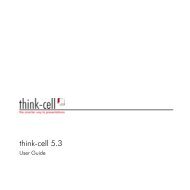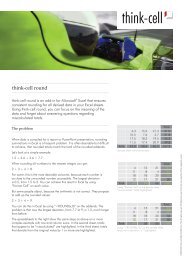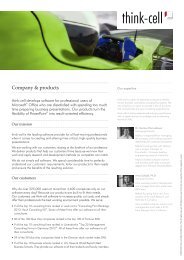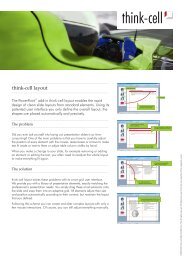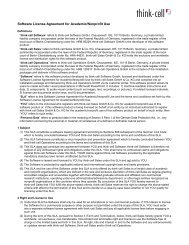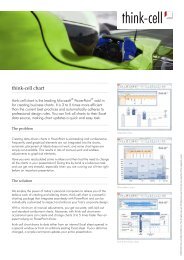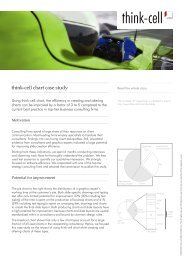think-cell technical report TC2003/01 A GUI-based Interaction ...
think-cell technical report TC2003/01 A GUI-based Interaction ...
think-cell technical report TC2003/01 A GUI-based Interaction ...
You also want an ePaper? Increase the reach of your titles
YUMPU automatically turns print PDFs into web optimized ePapers that Google loves.
6.2 Case Study EVALUATION<br />
presented that suggests that the concepts of this work support the speed-up goals<br />
of the over-all application.<br />
6.2.1 Question<br />
The ultimate goal of the application is a speedup-factor of about 5 in the PowerPoint-<br />
related workflow of a business consultancy. While using plain PowerPoint, the ne-<br />
cessity to rearrange elements when text comes into play becomes the major time<br />
consumer. Depending on the quantity of text that the different shapes contain, the<br />
slide is iteratively refined until all text is readably sized and nicely wrapped, all<br />
elements are aligned and have uniformly distributed space between them, and so<br />
forth. An increase of efficiency is expected to result from the solver that updates<br />
and maintains relations between elements on the slide whenever the user makes<br />
some arbitrary addition or modification. With this approach, all the time that is<br />
currently spent in iteratively rearranging the slide layout, would be eliminated.<br />
In this scenario, it is important that the user interaction required to specify<br />
layout constraints does not require any more effort or time than the user interaction<br />
that is currently required to create a pixel-<strong>based</strong> layout in PowerPoint. It is therefore<br />
the job of the user interface and the goal of my thesis to facilitate the constraint-<br />
<strong>based</strong> specification of a certain layout in the same or less time than it takes to<br />
specify the same layout using plain PowerPoint.<br />
6.2.2 Setup<br />
To validate the concepts implemented in my prototype, I chose a representative<br />
sample of 20 slides from a number of original business presentations. The case study<br />
was designed to compare two conditions: The user interface of plain PowerPoint<br />
vs. the user interface presented in this work. For each condition, I had an expert<br />
copy the layout of those 20 slides from a printout to a PowerPoint slide or smart<br />
grid, respectively. In order to measure the impact of the user interface for layout<br />
specification as precisely as possible, no text or formatting was applied to the slides.<br />
That way, the influence of automatic text wrapping and constraint-maintaining<br />
layout was excluded from the measurement and the times taken are exclusively due<br />
to user interaction that specifies alignment of shapes.<br />
To measure time for the plain PowerPoint interface, I hired a professional from<br />
a business consultancy’s visual pool, who was rated by his superior as one of the<br />
fastest PowerPoint users in the team. As the only available expert for the new smart<br />
grid user interface, the author did the timing by himself. Both experts created the<br />
20 slides in the same order and in one batch.<br />
6.2.3 Results<br />
Figure 48 lists the results from the competition. For 3<br />
4 of all slides as well as on the<br />
average, the smart grid interaction concept was faster to use than the traditional<br />
PowerPoint UI. In 3 cases the speedup difference was greater than 60 %. Based on<br />
85



